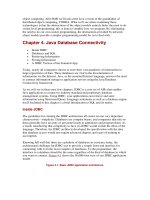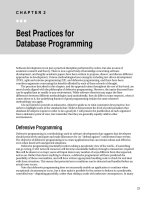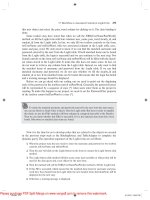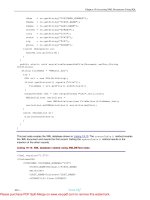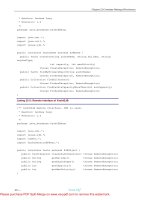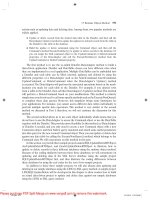Java Database Programming Bible- P12
Bạn đang xem bản rút gọn của tài liệu. Xem và tải ngay bản đầy đủ của tài liệu tại đây (823.97 KB, 50 trang )
Chapter 22:Container -Managed Persistence
-551 -
* @author: Andrew Yang
* @version: 1.0
*/
package java_database.YachtEBean;
import java.rmi.*;
import java.util.*;
import javax.ejb.*;
public interface YachtHome extends EJBHome {
public Yacht create(String yachtName, String builder, String
engineType,
int capacity, int maxVelocity)
throws CreateException, RemoteException;
public Yacht findByPrimaryKey(String yachtName)
throws FinderException, RemoteException;
public Collection findAllYachts()
throws FinderException, RemoteException;
public Collection findYachtsCapacityMoreThan(int minCapacity)
throws FinderException, RemoteException;
}
Listing 22-2: Remote interface of YachtEJB
/** YachtEJB Remote Interface. CMP is used.
* @author: Andrew Yang
* @version: 1.0
*/
package java_database.YachtEBean;
import java.rmi.*;
import javax.ejb.*;
import common.*;
import YachtSessionSFBean.*;
public interface Yacht extends EJBObject {
public YachtSession createYachtSession() throws RemoteException;
public String getBuilder() throws RemoteException;
public String getEngineType() throws RemoteException;
public int getCapacity() throws RemoteException;
public int getMaxVelocity() throws RemoteException;
}
TEAMFLY
Team-Fly
®
Please purchase PDF Split-Merge on www.verypdf.com to remove this watermark.
Chapter 22:Container -Managed Persistence
-552 -
Although multiple create methods can be defined, only one create method is defined in the home
interface for simplicity. The create method takes all of the five persistent fields as argument. The
remote interface defines the getters for four out of the five persistent fields, except the primary key
field. The client can get the primary key field, yachtName, by calling the getPrimaryKey method of
the EJBHome class or EntityContext class.
Three finder methods are defined in the home interface with different data-retrieval criteria. The
findByPrimaryKey is required and returns only one reference to YachtEJB that the primary key
identifies. It may return null if no match is found. The other two methods return a collection of references
to YachtEJB objects.
There are only getters; no setters are defined in the remote interface; therefore the YachtEJB is
apparently defined as read only (after created) from the clients' point of view. If the clients also need to
modify the persistent state, setters for the persistent fields must be defined in the remote interface.
Although getters and setters are defined in the remote interface, you do not need to code their
implementations, as you see in the next section.
Implementation Class with Minimum Code
In EJB 1.1, a persistent field was identified in the deployment descriptor and also identified as a public
instance variable of your bean implementation class. In EJB 2.0, this approach has been radically
changed. Persistent fields are still identified in the deployment descriptor, but they are not identified as
public-instance variables. Instead, they are identified through specialized getters and setters that
you must write.
For example, you have to write getYachtName, setBuilder, and so on in the YachtEJB
implementation class. What is intriguing is that these methods are declared as abstract and are
implemented automatically by the EJB container during the deployment phase. That makes the
implementation class also abstract; thus, no instance can be instantiated directly for the implementation
class. The EJB container uses the information you provide in the deployment descriptor to automatically
generate a concrete class with all the database-access implementations. The objects of these
container-generated, concrete classes are used at runtime for clients' invocation. The implementation
class of the example YachtEJB is shown in Listing 22-3.
Listing 22-3: Implementation class of YachtEJB
/** YachtEJB Implementation Class. CMP is used.
* @author: Andrew Yang
* @version: 1.0
*/
package java_database.YachtEBean;
import java.rmi.*;
import java.util.*;
import java.sql.*;
import javax.ejb.*;
import javax.naming.*;
import common.*;
import YachtSessionSFBean.*;
public abstract class YachtBean implements EntityBean {
private EntityContext context;
Please purchase PDF Split-Merge on www.verypdf.com to remove this watermark.
Chapter 22:Container -Managed Persistence
-553 -
private InitialContext ctx;
public YachtBean() {
try {
ctx = new InitialContext();
} catch (Exception e) {
System.out.println("Problem getting InitialContext!");
}
}
public void setEntityContext(EntityContext ctx) { this.context = ctx; }
public void unsetEntityContext() { }
public void ejbActivate() { }
public void ejbPassivate() { }
public void ejbLoad() { }
public void ejbStore() { }
public void ejbRemove() throws RemoveException { // nothing to code }
// Container managed fields
public abstract String getYachtName();
public abstract String getBuilder();
public abstract String getEngineType();
public abstract int getCapacity();
public abstract int getMaxVelocity();
public abstract void setYachtName(String s);
public abstract void setBuilder(String s);
public abstract void setEngineType(String s);
public abstract void setCapacity(int n);
public abstract void setMaxVelocity(int n);
public String ejbCreate(String yachtName, String builder, String
engineType,
int capacity, int maxVelocity)
throws CreateException {
// You have to call accessor methods here.
setYachtName(yachtName);
setBuilder(builder);
setEngineType(engineType);
setCapacity(capacity);
setMaxVelocity(maxVelocity);
// If int values passed in are zero, pull the value from the constant
file.
if(capacity <= 0) { setCapacity(YachtConstants.CAPACITY); }
if(maxVelocity <= 0) { setMaxVelocity(YachtConstants.MAX_VELOCITY); }
Please purchase PDF Split-Merge on www.verypdf.com to remove this watermark.
Chapter 22:Container -Managed Persistence
-554 -
// Always return null
return null;
}
public void ejbPostCreate(String yachtName, String builder, String
engineType,
int capacity, int maxVelocity) {
// nothing to code
}
// Business Methods
public YachtSession createYachtSession() {
YachtSession session = null;
try {
YachtSessionHome home = (YachtSessionHome)ctx.lookup(
"java:comp/env/ejb/YachtSessionEJB");
// In order to create a YachtSession instance, we must pass
// in a reference to this Yacht EJB's remote stub.
session = (YachtSession)home.create((Yacht)context.getEJBObject());
} catch (Exception e) {
System.out.println("Failed to create YachtSession: " + e);
}
return session;
}
}
You may be impressed by how little you have to code. Compared with the BMP implementation given in
Listing 21-6, the CMP implementation class has much less code. This leads to one of the major
advantages of CMP entity bean — a fast development cycle.
From Listing 22-3, you see that the implementation classes have defined five abstract getters and
five abstract setters for the five persistent fields. The concrete implementation is automatically
generated by the EJB container based on the information provided in the deployment descriptor. As an
example, the YachtEJB's deployment descriptor for WebLogic Application Server 6.0 is shown in
Listing 22-4. If you use another application server, your deployment descriptor files may look slightly
different. When your application contains multiple EJBs, and some other components such as servlets,
the deployment descriptor can be very long and complex. Therefore, you should never write your
deployment descriptors with a text editor. Instead, always use the deployment tool provided by your
application server. These XML files should always be generated by your application server, just as all
the concrete implementations of the abstract EJB methods are automatically generated by EJB
container.
Note
Do not use a text editor to write a deployment descriptor. Use the deployment tool
provided by your application server.
Listing 22-4: Deployment descriptor for YachtEJB
# First DD File – J2EE Standard
Please purchase PDF Split-Merge on www.verypdf.com to remove this watermark.
Chapter 22:Container -Managed Persistence
-555-
<!DOCTYPE ejb-jar PUBLIC "-//Sun Microsystems, Inc.//DTD Enterprise
JavaBeans 2.0//EN"
"
<ejb-jar>
<enterprise-beans>
<entity>
<ejb-name>YachtEJB</ejb-name>
<home>YachtEBean.YachtHome</home>
<remote>YachtEBean.Yacht</remote>
<ejb-class>YachtEBean.YachtBean</ejb-class>
<persistence-type>Container</persistence-type>
<prim-key-class>java.lang.String</prim-key-class>
<reentrant>False</reentrant>
<cmp-version>2.x</cmp-version>
<abstract-schema-name>YachtBean</abstract-schema-name>
<primkey-field>yachtName</primkey-field>
<cmp-field><field-name>builder</field-name></cmp-field>
<cmp-field><field-name>engineType</field-name></cmp-field>
<cmp-field><field-name>capacity</field-name></cmp-field>
<cmp-field><field-name>maxVelocity</field-name></cmp-field>
<ejb-ref>
<description>The YachtEJB does a lookup for YachtSession
beans.</description>
<ejb-ref-name>ejb/YachtSessionEJB</ejb-ref-name>
<ejb-ref-type>Session</ejb-ref-type>
<home>YachtSessionSFBean.YachtSessionHome</home>
<remote>YachtSessionSFBean.YachtSession</remote>
</ejb-ref>
<query>
<query-method>
<method-name>findAllYachts</method-name>
<method-params></method-params>
</query-method>
<ejb-ql><![CDATA[WHERE yachtName IS NOT NULL]]></ejb-ql>
</query>
<query>
<query-method>
<method-name>findYachtsCapacityMoreThan</method-name>
<method-params>
<method-param>int</method-param>
</method-params>
</query-method>
<ejb-ql><![CDATA[FROM YachtBean cb WHERE cb.capacity > ?1]]></ejb-
ql>
Please purchase PDF Split-Merge on www.verypdf.com to remove this watermark.
Chapter 22:Container -Managed Persistence
-556 -
</query>
</entity>
</enterprise-beans>
<assembly-descriptor>
<security-role>
<description>The group of users allowed to access
YachtEJBs.</description>
<role-name>ValidYachtClubUsers</role-name>
</security-role>
<container-transaction>
<method>
<ejb-name>YachtEJB</ejb-name>
<method-intf>Remote</method-intf>
<method-name>*</method-name>
</method>
<trans-attribute>Required</trans-attribute>
</container-transaction>
</assembly-descriptor>
</ejb-jar>
# Second DD File – Weblogic Specific
<!DOCTYPE weblogic-ejb-jar PUBLIC '-//BEA Systems, Inc.//DTD WebLogic 6.0.0
EJB//EN'
'
<weblogic-ejb-jar>
<weblogic-enterprise-bean>
<ejb-name>YachtEJB</ejb-name>
<entity-descriptor>
<entity-cache>
<max-beans-in-cache>150</max-beans-in-cache>
</entity-cache>
<persistence>
<persistence-type>
<type-identifier>WebLogic_CMP_RDBMS</type-identifier>
<type-version>6.0</type-version>
<type-storage>META-INF/weblogic-cmp-rdbms-jar.xml</type-storage>
</persistence-type>
<persistence-use>
<type-identifier>WebLogic_CMP_RDBMS</type-identifier>
<type-version>6.0</type-version>
</persistence-use>
</persistence>
</entity-descriptor>
<reference-descriptor>
Please purchase PDF Split-Merge on www.verypdf.com to remove this watermark.
Chapter 22:Container -Managed Persistence
-557 -
<ejb-reference-description>
<ejb-ref-name>ejb/YachtSessionEJB</ejb-ref-name>
<jndi-name>YachtSessionEJB</jndi-name>
</ejb-reference-description>
</reference-descriptor>
<jndi-name>YachtEJB</jndi-name>
</weblogic-enterprise-bean>
<security-role-assignment>
<role-name>ValidYachtClubUsers</role-name>
<principal-name>system</principal-name>
</security-role-assignment>
</weblogic-ejb-jar>
# Third DD File – Persistent Field Mapping, Weblogic Specific
<!DOCTYPE weblogic-rdbms-jar PUBLIC '-//BEA Systems, Inc.//DTD WebLogic
6.0.0 EJB RDBMS
Persistence//EN' ' />persistence-
600.dtd'>
<weblogic-rdbms-jar>
<weblogic-rdbms-bean>
<ejb-name>YachtEJB</ejb-name>
<data-source-name>yachtClub-datasource</data-source-name>
<table-name>yacht</table-name>
<field-map>
<cmp-field>yachtName</cmp-field>
<dbms-column>yacht_name</dbms-column>
</field-map>
<field-map>
<cmp-field>builder</cmp-field>
<dbms-column>builder</dbms-column>
</field-map>
<field-map>
<cmp-field>engineType</cmp-field>
<dbms-column>engine_type</dbms-column>
</field-map>
<field-map>
<cmp-field>capacity</cmp-field>
<dbms-column>capacity</dbms-column>
</field-map>
<field-map>
<cmp-field>maxVelocity</cmp-field>
<dbms-column>max_velocity</dbms-column>
</field-map>
Please purchase PDF Split-Merge on www.verypdf.com to remove this watermark.
Chapter 22:Container -Managed Persistence
-558-
</weblogic-rdbms-bean>
</weblogic-rdbms-jar>
Recall that the deployment-descriptor files are supposedly read by the EJB container, not by people. I
list them here just for the demonstration of some key concepts. Don't try to write or read these files
using a text editor. Use the deployment tools instead.
As you see from the Listing 22-4, you specify the abstract schema name (YachtBean), the primary key
field (yachtName), and all other persistent fields (builder, engineType, capacity and
maxVelocity) in the deployment descriptor, as follows:
<persistence-type>Container</persistence-type>
<abstract-schema-name>YachtBean</abstract-schema-name>
<primkey-field>yachtName</primkey-field>
<cmp-field><field-name>builder</field-name></cmp-field>
<cmp-field><field-name>engineType</field-name></cmp-field>
<cmp-field><field-name>capacity</field-name></cmp-field>
<cmp-field><field-name>maxVelocity</field-name></cmp-field>
You further declare the persistent type as CMP, as shown here:
<persistence-type>Container</persistence-type>
<persistence-type>
<type-identifier>WebLogic_CMP_RDBMS</type-identifier>
… …
</persistence-type>
You then define the mapping between YachtEJB and the underlying persistent store (yachtClub-
datasource) by specifying the mapping between each persistent field and its corresponding table-
column name (such as yachtName mapped to yacht_name, maxVelocity mapped to
max_velocity, and so on), as follows:
<ejb-name>YachtEJB</ejb-name>
<data-source-name>yachtClub-datasource</data-source-name>
<table-name>yacht</table-name>
<field-map>
<cmp-field>yachtName</cmp-field>
<dbms-column>yacht_name</dbms-column>
</field-map>
<field-map>
<cmp-field>builder</cmp-field>
<dbms-column>builder</dbms-column>
</field-map>
… …
Such information tells the EJB container to implement the access calls for these persistent fields. Based
on the deployment information, the EJB container determines the approperate JDBC implementations
(that is, the SQL calls) for the persistent fields and keeps a CMP bean's persistent field synchronized
with the state of the database record it represents. After the concrete classes are generated during the
Please purchase PDF Split-Merge on www.verypdf.com to remove this watermark.
Chapter 22:Container -Managed Persistence
-559 -
deployment phase, the life cycle of these CMP bean instances are same as that of BMP instances
discussed in the previous Chapter 21.
For each create method defined in the home interface, you need to write a corresponding ejbCreate
method. As a bean developer, your job is to assign the persistent fields with their initial values by calling
the setters. You may find something weird by looking at the implementation shown in Listing 21-3.
Although the return type is supposed to be the primary key, the ejbCreate method actually returns
null at the end of the code. This is required by EJB specification. The rationale is that this method will
only be called by the EJB container and that the container always knows exactly what the primary key is
for each EJB.
Note
For a BMP bean, you must write code for the ejbRemove method. For a CMP bean,
since the database-access logic is implemented by the EJB container, you typically do
not need to write any code.
In the code shown in Listing 22-3, you do not see even the empty implementation of any finder
method defined in the home interface. How does the EJB container generate the implementation for
finder methods? For the method findByPrimaryKey, the container knows how to implement it by
looking at the primary key class type in the deployment descriptor and the corresponding database
column specified. For implanting all other methods, the EJB container follows your orders, given in the
form of EJB QL in the deployment descriptor. The EJB QL is discussed in detail later.
You still need to implement all the business methods defined in the remote interface, except for the
getters and setters. In the YachtBean, you only need to code the business method
createYachtSession. You first look up the YachtSessionEJB's home interface from JNDI, then
create a remote interface handle. Since this will always be an EJB-to-EJB call, you may want to use
YachtSessionEJB's local interface for better performance.
To summarize this discussion, Table 22-2 lists major differences between coding a BMP bean
implementation class and coding a CMP implementation class. All the database-access calls by bean
developers for BMP beans are automatically generated by the EJB container. Since the bean-
implementation classes you write contain no implementations, it is important to declare them as abstract.
The corresponding concrete classes are automatically generated by EJB container at the deployment
phase.
Table 22-2: Coding Differences between CMP and BMP
Item CMP BMP
Class Definition Abstract Not abctract
Database access calls Generated by tools Coded by developers
Persistent state Represented by virtual persistent
fields
Coded as instance variables
Accessor to persistent and
relationship fields
Required None
Customized finder
methods
Handled by EJB container (but
the developer must define the
EJB QL queries)
Coded by developers
Select Methods (??) Handled by EJB container None
Return type of ejbCreate
method
null Primary key
With CM entity bean, no database code is needed. The database access functionality is specified by
EJB developers or application assemblers in description descriptor in EJB Query language that is
discussed next.
Please purchase PDF Split-Merge on www.verypdf.com to remove this watermark.
Chapter 22:Container -Managed Persistence
-560-
EJB Query Language
The EJB Query Language (EJB QL) is used to define query methods (for example, finder and
select methods) for CMP entity beans. EJB QL, which is based on SQL-92, can be compiled
automatically by the EJB container to a target language, such as SQL, of a database or other types of
persistent stores. This makes CMP entity beans more portable and much easier to deploy.
An EJB QL query has these three clauses:
§ SELECT
§ FROM
§ WHERE
The SELECT and FROM clauses are required, but the WHERE clause is optional. Here is the high-level
BNF syntax of an EJB QL query:
EJB QL :: = select_clause from_clause [where_clause]
The SELECT clause defines the types of the objects or values that the query returns. A return type is a
remote interface, a local interface, or a persistent field.
The FROM clause defines the scope of the query by declaring one or more identification variables, which
may be referenced in the SELECT and WHERE clauses. An identification variable represents one of the
following elements:
§ The abstract schema name of an entity bean
§ A member of a collection that is the multiple side of a one-to-many relationship
The WHERE clause is a conditional expression that restricts the objects or values retrieved by the query.
Although this is optional, most queries have a WHERE clause.
You now may have found that the syntax of EJB QL is quite similar to the syntax of SQL. They do have
a lot of similarities. However, EJB QL is not like SQL in the following aspects:
§ SQL deals with tables and rows, but EJB QL deals with objects and instances.
§ SQL has many built-in functions that EJB QL does not have.
§ The result of an EJB QL is a remote interface or a collection of remote interfaces.
For each method (except the findByPrimaryKey method) in your CMP entity bean, there must be a
<query> tag that describes this finder method. In the deployment descriptor, the EJB QL must be
wrapped in an expression that looks like this:
<!CDATA[expression]]>
expression is a valid EJB QL statement. The CDATA statement is not necessary but is recommended
because it escapes the reserved characters of XML. Since the object to be selected is obvious for these
finder methods, you do not need to put the SELECT clause into the expression. In many cases, if the
data is selected from a single entity bean object and there is no relationship that needs to be specified,
the FROM clause can be omitted too.
Look at the deployment descriptor shown in Listing 22-4. The EJB QL for the findAllYachts method
is as follows:
<ejb-ql><![CDATA[WHERE yachtName IS NOT NULL]]></ejb-ql>
This is translated to the following SQL statement by EJB container at the deployment phase if, for
example, an Oracle database is used:
SELECT * FROM yacht
The EJB QL for the findYachtsCapacityMoreThan method is as follows:
<ejb-ql><![CDATA[FROM YachtBean cb WHERE cb.capacity > ?1]]></ejb-ql>
It may be translated into a SQL statement like this:
Please purchase PDF Split-Merge on www.verypdf.com to remove this watermark.
Chapter 22:Container -Managed Persistence
-561-
SELECT * FROM yacht WHERE yacht.capacity > parameter_1
The parameter_1 is passed into the statement at runtime.
In addition to finder methods, you can use EJB QL to do any number of querying activities. EJB QL
allows you to do simple queries; compound queries; queries that invoke the persistent fields of more
than one EJB; queries that use finder methods on other EJBs; and queries that use persistent fields
accessible through a relationship to other EJBs. In other words, EJB QL is a very powerful tool.
However, it has also the following restrictions:
§ Comments are not allowed.
§ Date and time values are in milliseconds and use Java long data type. A date or time literal
should be an integer literal. To generate a millisecond value, you may use the
java.util.Calendar class.
§ Currently, CMP does not support inheritance. For this reason, two entity beans of different types
cannot be compared.
Note
This section covers only the simplified syntax of EJB QL. The full syntax is beyond the
scope of this book. Interested readers can find a detailed description on EJB QL in
many EJB books.
By now you have learnt how to develop and deploy CMP EJBs. Let us move on to run the example
application.
Running the Example Application
Remember the yacht club application discussed first in Chapter 20? It is uses by a yacht club to
manage its yacht-cruise operation. As a treat, the club offers its member free yacht cruises. The
business process includes the following:
§ Operating the yacht — such as starting, stoping, speeding up and slowing down
§ Checking the status of the yacht — such as current velocity, maximum velocity, current passenger
on board, and so on
§ Picking up club members if there is enough room
§ Dropping off passengers
Over the last three chapters, you have built these three EJBs:
§ Stateful session bean YachtSessionEJB
§ BMP entity bean MemberEJB
§ CMP entity bean YachtEJB.
You can use them to build the simple yacht club application.
As an example, Listing 22-5 shows a JSP client that allows you to manage the yachts that the club
owns.
Listing 22-5: YachtManager.jsp
<%@ page import="javax.naming.*, java.rmi.*, javax.ejb.*, YachtEBean.*,
common.*"
session="true" %>
<%
{
YachtHome home = (YachtHome)ctx.lookup("YachtEJB");
if (request.getParameter("DestroyYacht") != null) {
String pk = null;
TEAMFLY
Team-Fly
®
Please purchase PDF Split-Merge on www.verypdf.com to remove this watermark.
Chapter 22:Container -Managed Persistence
-562-
try {
pk = request.getParameter("DestroyYacht");
home.remove(pk);
session.removeAttribute(pk); // destroy the associated session
} catch (NumberFormatException e) {
log("Failed to destroy a Yacht.", out);
}
}
else if (request.getParameter("CreateNewYacht") != null) {
String yachtName = request.getParameter("YachtName");
if(yachtName == null) {
yachtName = "DefaulName";
}
String builder = request.getParameter("Builder");
if (builder == null) {
builder = "Unknown";
}
String engineType = request.getParameter("EngineType");
if (engineType == null) {
engineType = "Unknown";
}
int capacity = 0;
int maxVelocity = 0;
try {
capacity = Integer.parseInt(request.getParameter("Capacity"));
} catch (Exception e) {
capacity = 10;
}
try {
maxVelocity = Integer.parseInt(request.getParameter("MaxVelocity"));
} catch (Exception e) {
maxVelocity = 25;
}
// finally create the Yacht
try {
Yacht yacht = (Yacht) home.create(yachtName, builder, engineType,
capacity,
maxVelocity);
} catch (CreateException e) {
log("CreateException caught while trying to create a new yacht." +
e, out);
}
}
Please purchase PDF Split-Merge on www.verypdf.com to remove this watermark.
Chapter 22:Container -Managed Persistence
-563-
Collection coll = null;
if (request.getParameter("MinCapacity") != null) {
int minCapacity = 0;
try {
minCapacity = Integer.parseInt(request.getParameter("MinCapacity"));
} catch (Exception e) {
minCapacity = 10;
}
coll = home.findYachtsCapacityMoreThan(minCapacity);
} else {
coll = home.findAllYachts();
}
%>
<html><head><title>Manage Yacht</title></head><body>
<b>Yachts</b><br>
<%
Iterator iter = coll.iterator();
%>
<table width="400" border="thin" cellpadding="0" cellspacing="0">
<%
while (iter.hasNext()) {
Yacht yacht = (Yacht)iter.next();
%>
<tr><td width="25%"><%= (String)yacht.getPrimaryKey() %></td>
<td width="25%"><%= yacht.getCapacity() %></td>
<td width="25%"><a href=YachtSessionManager.jsp?YachtPK=<%=
(String)yacht.getPrimaryKey() %>&Action=View>View
Session</a></td>
<td width="25%"><a href=YachtManager.jsp?DestroyYacht=<%=
(String)yacht.getPrimaryKey() %>>Destroy</a></td></tr>
<%
}
%>
</table>
<%
}
%>
<FORM action=YachtManager.jsp>
<b>Create a New Yacht:</b><BR>
<table>
<tr><td>Yacht Name:</td>
<td><INPUT TYPE=TEXT NAME=YachtName></td>
Please purchase PDF Split-Merge on www.verypdf.com to remove this watermark.
Chapter 22:Container -Managed Persistence
-564-
<td>Builder:</td>
<td><INPUT TYPE=TEXT NAME=Builder></td></tr>
<tr><td>Engine Type:</td>
<td><INPUT TYPE=TEXT NAME=EngineType></td>
<td>Capacity:</td>
<td><INPUT TYPE=TEXT NAME=Capacity></td></tr>
<tr><td>Maximum Velocity:</td>
<td><INPUT TYPE=TEXT NAME=MaxVelocity></td>
<td></td>
<td>><INPUT TYPE=SUBMIT NAME="CreateNewYacht"
VALUE=Create></td></tr>
</table>
<b>Search Yachts Big Enough:</b><br>
<table>
<tr><td>Find yachts with capacity more than: </td>
<td><INPUT TYPE=TEXT NAME=MinCapacity></td>
<td><INPUT TYPE=SUBMIT Value="Find"></td></tr>
</table>
</FORM>
<%!
private static Context ctx;
static {
try {
ctx = new InitialContext();
} catch (Exception e) {
System.out.println("Error trying to do one time
initialization.\n" + e);
}
}
public void log(String logMsg, JspWriter out) throws Exception {
out.print(logMsg + "<BR>");
}
%>
</body>
</html>
This JSP client allow you to add a new yacht to the yacht club's possession, to remove a yacht, and to
search for yachts that have a capacity over a give number. The name and capacity of the yacht that
meet the searching criteria are listed at the top of the browser screen. By clicking the hyperlink marked
"Destroy," the corresponding yacht is removed from the database. When adding a new yacht, you need
to provide the five persistent attributes of the yacht, namely, yacht name, its builder, the engine type,
capacity, and maximum velocity. An output screen for running this JSP client is illustrated in Figure 22-1.
Please purchase PDF Split-Merge on www.verypdf.com to remove this watermark.
Chapter 22:Container -Managed Persistence
-565-
Figure 22-1: Output of ManageYacht client
By clicking the hyperlink marked "View Session," you should be able to view the session associated
with this yacht (that is, whether it is in an active cruise operation, the current status such as velocity and
passenger list, and so on). From the code in Listing 22-5, you can see that clicking the View Session
hyperlink sends a request to another JSP client: YachtSessionjManager. jsp, as shown here:
<a href=YachtSessionManager.jsp?YachtPK=<%= (String)yacht.getPrimaryKey() %>
&Action=View>View Session</a>
The code for YachtSessionjManager.jsp is not provided here, and I do it on purpose. By now you
should be able to write your own client to use these EJBs to meet your own needs. You have learned all
the skills you need to access these EJBs from your own client. Do this as an exercise!
Your yacht-session-management client should allow a user to check whether a cruise session is active.
If no active session is associated with the yacht the user has selected, the user should be prompt to
create a session. Once a cruise session is created (or retrieved), the user should be able to operate the
cruising yacht. That means the user is able to start, stop, accelerate and decelerate the yacht, check the
yacht status, drop off passengers, pick up members, and so on.
Because only members can come on board, you do need the help of MemberEJB to implement the
preceding functionality. You can write a JSP client, a Swing client, or a stand-along client. If you decide
to use the JSP client, you may be able to take advantage of the functionality provided by the
HttpSession interface. For example, once a YachtSessionEJB instance session is created, you can
save it to HttpSession as follows:
session.setAttribute(yachtPrimaryKey, theYachtSession);
When a user wants to view the YachtSessionEJB instance for a specific yacht, you just need to
retrieve it as follows:
myYachtSession = (YachtSession)session.getAttribute(yachtPrimaryKey);
When an active session is destroyed (that is, the cruise is completed), you remove the
YachtSessionEJB instance as follows:
session.removeAttribute(yachtPrimaryKey);
The session.removeAttribute(yachtPrimaryKey) method is called in the
YachtManager.jsp shown in Listing 22-5. When a yacht is removed, its associated YachtSession
is also removed.
To give you more hints, you may write a JSP client that provides a user interface similar to what is
shown in Figure 22-2. The yacht name and current status are shown on the top of the screen. A user
can start and stop the yacht. He or she can also speed up or slow down the yacht by a certain velocity.
Please purchase PDF Split-Merge on www.verypdf.com to remove this watermark.
Chapter 22:Container -Managed Persistence
-566-
Remember that business logic is built into the YachtSessionEJB that you cannot accelerate a
stopped yacht. You must start the yacht and then speed it up. You cannot stop a yacht that is running
too fast. You must slow it down to certain speed before stopping it. If you want to add business logic,
you can revisit the YachtSessionEJB code listed in Chapter 20 and make any modification you need.
Figure 22-2: Possible output screen of your yacht-session client
This example application is simplified to demonstrate the fundamentals of CMP EJB. However, an
important feature of CMP entity bean brought by EJB 2.0 is missing: the container managed relationship.
You will learn it in the next section.
Container-Managed Relationship
The entity beans you have seen so far in this book are detached objects that do not relate with each
other. This type of entity bean has only limited use because in real life objects are often linked and
depend upon each other. This kind of behavior has always existed in databases through primary keys
and foreign keys. With EJB 1.1, CMP entity beans had no easy way of representing the natural
interaction between entity objects. This has partially contributed to the slow adoption of CMP entity
beans in the early stage. To address this problem, the EJB 2.0 specification introduces a way to support
simple and complex relationships by introducing the container-managed relationship through the
relationship fields.
Relationship Field
A relationship field is like a foreign key in a database table — it identifies a related bean. Like a
persistent field, a relationship field is virtual and is defined in the enterprise-bean class with access
methods. But unlike a persistent field, a relationship field does not represent the bean's state. For
example, each yacht has an engine. Assume an EngineEJB is developed; it has a one-to-one
relationship with the YachtEJB you have written. To model YachtEJB's relationship to EngineEJB, it
has a relationship field: engine. In the deployment descriptor, you specify this relationship as follows:
<ejb-relation>
<ejb-relation-name>Yacht-Engine</ejb-relation-name>
<ejb-relationship-role>
<ejb-relationship-role-name>Yacht-Has-Engine</ejb-relationship-role-
name>
<multiplicity>one</multiplicity>
Please purchase PDF Split-Merge on www.verypdf.com to remove this watermark.
Chapter 22:Container -Managed Persistence
-567-
<role-source>
<ejb-name>YachtEJB</ejb-name>
</role-source>
<cmr-field>
<cmr-field-name>engine</cmr-field-name>
</cmr-field>
</ejb-relationship-role>
<ejb-relationship-role>
<ejb-relationship-role-name>Engine-In-Yacht</ejb-relationship-role-
name>
<multiplicity>one</multiplicity>
<role-source>
<ejb-name>EngineEJB</ejb-name>
</role-source>
</ejb-relationship-role>
</ejb-relation>
This part of the deployment descriptor tells the EJB container that each YachtEJB has one engine and
each EngineEJB may belong to a yacht. Thus, this is a one-to-one relationship. Since you can only find
the EngineEJB instance through a YachtEJB instance, not vice verse, this relationship is
unidirectional. Although similar to the primary-key and foreign-key relationships in a database, the EJB
relationships do not work the same way as relationships in database. An EJB relationship binds two
EJBs together through object graphs to have in-memory object graphs mapped to an underlying
database schema. For example, the YachtEJB owns an EngineEJB; thus, when a YachtEJB
instance is instantiated, an associated EngineEJB instance must also be instantiated and placed in the
EJB container's memory for a client to access. In other words, the EJB relationship is enforced and
adhered to by the EJBs and the EJB container.
Cardinality and Direction of Relationship
The XML elements used in the deployment descriptor to describe the container managed can become
very complex, as they must deal with both the cardinality and direction (unidirectional vs. bidirectional)
of the relationships.
Cardinality indicates the number of EJBs. The four types of multiplicities are as follows:
§ One-to-one: Each entity-bean instance is related to a single instance of another entity bean. For
example, if each yacht has only one engine, YachtEJB and EngineEJB will have a one-to-one
relationship.
§ One-to-many: An entity-bean instance may be related to multiple instances of the other entity
bean. In real life, yachts have twin engines, and some have even more engines. To reflect this fact,
the YachtEJB has a one-to-many relationship with EngineEJB.
§ Many-to-one: Multiple instances of an entity bean may be related to a single instance of the other
entity bean. This multiplicity is the opposite of a one-to-many relationship. In the example
mentioned in the previous item, from the perspective of EngineEJB the relationship to YachtEJB
is many-to-one.
§ Many-to-many: The entity-bean instances may be related to multiple instances of each other. For
example, in college, each course has many students, and every student may take several courses.
Therefore, in an enrollment application, CourseEJB and StudentEJB have a many-to-many
relationship.
The direction of a relationship may be either bidirectional or unidirectional. In a bidirectional relationship,
each entity bean has a relationship field that refers to the other bean. Through the relationship field, an
entity bean's code can access its related object. If an entity bean has a relative field, we often say that it
Please purchase PDF Split-Merge on www.verypdf.com to remove this watermark.
Chapter 22:Container -Managed Persistence
-568-
"knows" about its related object. For example, if CourseEJB knows which StudentEJB instances it
has and, at the same time, StudentEJB knows which CourseEJB it is associated with, they have a
bidirectional relationship.
In a unidirectional relationship, only one entity bean has a relationship field that refers to the other. Look
at the snipet of the deployment descriptor given on the previous page; YachtEJB has a relationship
field that identifies EngineEJB, but EngineEJB does not have a relationship field for YachtEJB. In
other words, YachtEJB knows about EngineEJB, but EngineEJB doesn't know which YachtEJB
instances refer to it.
EJB QL queries often navigate across relationships. The direction of a relationship determines whether
a query can navigate from one bean to another. For example, a query can navigate from YachtEJB to
EngineEJB but cannot navigate in the opposite direction. For CourseEJB and StudentEJB, a query
can navigate in both directions, since these two beans have a bidirectional relationship.
Access to Relationship Field
During development, you implement the relationship fields in a similar way to persistent fields. They are
defined in the deployment descriptor, and they have their getters and setters defined in the bean-
implementation class. They can even be exposed in the remote interface. By following a strict syntax for
authoring relationship fields in the bean-implementation class and in the deployment descriptor, the EJB
container is able to implement the relationship automatically behind the scene.
The rules for writing relationship-field accessor methods in a bean-implementation class are listed
here:
§ Both getters and setters for every relationship field must exist in the implementation class.
§ These getters and setters must be declared as abstract and must contain no implementation
code.
§ These accessor methods must begin with get or set; and the text following get/set must
match the name of the relationship field as it is declared in the deployment descriptor.
§ These getters and setters that do not access Collections may be optionally placed in the
remote interface.
If you want the clients to use the relationship-field accessor method, put the getters or setters in
the remote interface. But the last rule says that you may only do this if the method does not access a
Collection of objects. Only the entity bean's other business methods can use its own Collection
relationship.
Why does such a restriction exist? It is imposed for better performance. For a one-to-many relationship,
a getter may return a Collection of the related EJB objects. For example, the OrderEJB and
LineItemEJB are linked by lineItem field of the OrderEJB. The getLineItems() method may
return tens or hundreds of LineItemEJB instances, but you may want to work only on one of these
LineItemEJB instances. Imagine the network traffic it produces! To avoid the potential performance
nightmare, the last rule given in the preceding list is imposed. If you really need to get the whole list of
the elements to the client, you must define your own (nonabstract) utility accessor method like this:
Public ArrayList getAlLineItems() {
ArrayList list = new ArrayList();
// call the abstract relationship field accessor and walk through the
Collection
Iterator iter = getLineItems().iterator();
While (iter.hasNext()) {
List.add(iter.next())
}
}
Please purchase PDF Split-Merge on www.verypdf.com to remove this watermark.
Chapter 22:Container -Managed Persistence
-569-
Inside your own utility accessor method, you can call the bean's abstract getter that returns a
Collection. This tells the EJB container that you really need to get the whole list and that it is not the
container's responsibility to ensure good performance.
The ejbPostCreate method in Listing 22-3 is empty. However, if there are any relationship fields, you
must put these fields' initialization code in this method. Although all the persistent fields must be set in
the ejbCreate method, it is important to not set any relationship fields in the ejbCreate methods.
When ejbCreate is called, the bean has not yet been inserted into the underlying database. When
calling a setter method, the other EJB in the relationship also tries to update its references in the
related fields. This is not possible, since the EJB that is having ejbCreate method invoked has not yet
been created. You should initialize the relationship fields in the ejbPostCreate method.
Thus, if the YachtEJB is related to EngineEJB, the ejbPostCreate method may look like this:
public void ejbPostCreate(String yachtName, String builder, String
engineType,
int capacity, int maxVelocity, Engine engine) {
// initialize relationship field
setEngine(null);
}
In summary, implement relationships differently for BMP entity beans and CMP entity beans. With BMP,
the code you write implements the relationships. But with CMP, the EJB container takes care of the
relationships for you. Most information of the relationships is given in the deployment descriptor. A bean
developer needs to write very little code for the simple abstract getters and setters and some
initialization in the ejbPostCreate method. All these features make the CMP entity bean more
appealing because they are easier to develop and more flexible.
Summary
In this chapter, you learn how CMP entity beans handle the data persistence and object relationship.
Specifically, you learned:
§ The differences between CMP and BMP
§ How to achieve persistence through persistent fields
§ How to handle entity relationship through relationship fields
§ How to specify database access in EJB query language
This chapter concludes the discussion on EJBs. Over the past three chapters, three EJB have been
developed. You are encouraged to enhance their functionality and write your own client programs to use
these EJBs. In next chapter, you will learn another mechanism for data persistence: the Java data
object.
Please purchase PDF Split-Merge on www.verypdf.com to remove this watermark.
Chapter 23:Java Data Objects and Transparent Persistence
-570-
Chapter 23: Java Data Objects and Transparent
Persistence
In This Chapter
The focus of this chapter is on the transparent persistence and the standard way to achieve it: the Java
data object. After reading this chapter, you should have one more tool in you toolkit to design and
develop enterprise applications.
JDO for Transparent Persistence
So far, you have learned many ways to persist your application data such as Java serialization, JDBC,
entity EJBs, and so on. All these persistence mechanisms require that application programmers know
the details of the underlying database structure; most of them even require programmers to be
responsible for handling the details of persistence. To relieve application programmers from having to
know the details of the database structure, the recently released Java data object (JDO) specification
provides a high level of abstraction: transparent persistence.
Transparent persistence means that the persistence of data objects is automatic and that all logic for
processing persistent objects is expressed in pure Java language. The application programmers do not
need to know any database query languages such as SQL. The mapping of Java objects and the
persisted state of objects stored in the database is achieved behind the scene by the JDO provider
implementation and is totally transparent to application developers. From the application developer's
point of view, persistent objects are treated exactly the same as transient objects — instances that only
reside in JVM memory and do not persist outside of an application.
The two major goals of the JDO specification are:
§ Providing a standard interface between application objects and data stores (for instance, relational
databases, file systems, and so on)
§ Simplifying secure and scalable applications by providing developers with a Java-centric
mechanism for working with persistent data
Although lower-level abstractions for interacting with databases are still useful, the goal of JDO is to
reduce the need for explicit code for SQL and transaction handling in common business applications.
In addition to shielding the Java developers from the details of the underlying methods for providing
persistence, JDO acts as a standard layer between the application program and any back-end data
stores, whether it be a relational database, an XML database, a legacy application, a file system, or
flash RAM. Applications using the JDO interface can automatically plug in any data store that provides a
JDO implementation. This generally provides portability and increases the longevity of code.
JDO has come a long way to get here. It originated from Java Specification Request (JSR-012),
proposed in 1999. After three years of lengthy Java community process, it was finally approved as an
official specification in March 2002. In the meantime, many other requested specifications have become
standards, and the JDO work force has been dealing with the fact that JDO is able to be integrated into
the frameworks provided by these related specifications (mostly notably J2EE). Indeed, servlets and
session EJBs can directly manipulate JDO persistent instances instead of dealing with the underlying
data stores. Entity EJBs with bean-managed persistence can delegate business logic and persistence
management to JDO classes instead of forcing the developers writing all SQL commands in the
implementation classes. Integration of JDO with J2EE is discussed later in this chapter. First let us see
what makes JDO different from other data persistence mechanisms.
What Makes JDO an Unique Persistence Mechanism
In most cases, instances of Java classes reside in the memory of the running application. They are
destroyed when the program terminates. However, it is often desirable for the objects to persist even
Please purchase PDF Split-Merge on www.verypdf.com to remove this watermark.
